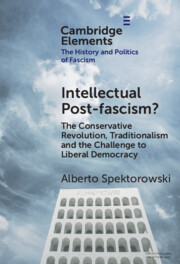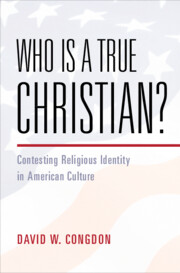Refine search
Actions for selected content:
19 results
Conclusion
-
- Book:
- An Islamic Legal Philosophy
- Published online:
- 19 November 2025
- Print publication:
- 27 November 2025, pp 240-256
-
- Chapter
- Export citation

Intellectual Post-fascism?
- The Conservative Revolution, Traditionalism and the Challenge to Liberal Democracy
-
- Published online:
- 23 June 2025
- Print publication:
- 10 July 2025
-
- Element
- Export citation
‘Men must fight, women must wait’: The war in Ukraine and Russian traditionalism
- Part of
-
- Journal:
- Memory, Mind & Media / Volume 4 / 2025
- Published online by Cambridge University Press:
- 20 March 2025, e2
-
- Article
-
- You have access
- Open access
- HTML
- Export citation
7 - Constitutional Identity as a Political Instrument
-
- Book:
- Constitutional Intolerance
- Published online:
- 09 January 2025
- Print publication:
- 23 January 2025, pp 104-126
-
- Chapter
- Export citation
The theological foundations of Muslim modernism and traditionalism in South Asia
-
- Journal:
- Modern Asian Studies / Volume 58 / Issue 2 / March 2024
- Published online by Cambridge University Press:
- 09 October 2024, pp. 357-385
- Print publication:
- March 2024
-
- Article
-
- You have access
- Open access
- HTML
- Export citation
2 - Recovering the Rule
-
- Book:
- Who Is a True Christian?
- Published online:
- 04 January 2024
- Print publication:
- 22 February 2024, pp 83-127
-
- Chapter
- Export citation
7 - Culture and the Public Sphere
-
- Book:
- Theorizing in Comparative Politics
- Published online:
- 04 January 2024
- Print publication:
- 18 January 2024, pp 100-115
-
- Chapter
- Export citation

Who Is a True Christian?
- Contesting Religious Identity in American Culture
-
- Published online:
- 04 January 2024
- Print publication:
- 22 February 2024
11 - Evaluating the Competing Arguments Regarding the Contemporary Use of Public Nuisance in Mass Tort Litigation
-
- Book:
- Public Nuisance
- Published online:
- 02 November 2023
- Print publication:
- 16 November 2023, pp 230-257
-
- Chapter
- Export citation
Chapter 23 - The Avant-Garde
- from Part III - Britten and Other Composers
-
-
- Book:
- Benjamin Britten in Context
- Published online:
- 31 March 2022
- Print publication:
- 21 April 2022, pp 200-212
-
- Chapter
- Export citation
7 - Matters of Faith
-
- Book:
- Survivors
- Published online:
- 27 January 2022
- Print publication:
- 17 February 2022, pp 192-225
-
- Chapter
- Export citation
Uncensored: Recovering Anti-Christian Animosity in Contemporary Rabbinic Literature
-
- Journal:
- Harvard Theological Review / Volume 114 / Issue 3 / July 2021
- Published online by Cambridge University Press:
- 03 August 2021, pp. 393-416
- Print publication:
- July 2021
-
- Article
- Export citation
5 - Reviving ‘Yoruba Religion’
-
- Book:
- Crossing Religious Boundaries
- Published online:
- 16 September 2021
- Print publication:
- 10 June 2021, pp 124-153
-
- Chapter
- Export citation
1 - Traditionalism and Salafism
- from Part I - History
-
- Book:
- Salafism and Traditionalism
- Published online:
- 08 March 2021
- Print publication:
- 18 March 2021, pp 9-38
-
- Chapter
- Export citation

Salafism and Traditionalism
- Scholarly Authority in Modern Islam
-
- Published online:
- 08 March 2021
- Print publication:
- 18 March 2021
Giving up omnipotence
-
- Journal:
- Canadian Journal of Philosophy / Volume 44 / Issue 1 / February 2014
- Published online by Cambridge University Press:
- 01 January 2020, pp. 97-117
-
- Article
- Export citation
14 - Antonin Scalia: Devout Christian; Worldly Judge?
-
-
- Book:
- Great Christian Jurists in American History
- Published online:
- 24 June 2019
- Print publication:
- 04 July 2019, pp 245-264
-
- Chapter
- Export citation
Knowing God by reason alone: what Vatican I never said
-
- Journal:
- New Blackfriars / Volume 91 / Issue 1033 / May 2010
- Published online by Cambridge University Press:
- 01 January 2024, pp. 215-228
- Print publication:
- May 2010
-
- Article
- Export citation
3 - The Chin dynasty
-
-
- Book:
- The Cambridge History of China
- Published online:
- 28 March 2008
- Print publication:
- 25 November 1994, pp 215-320
-
- Chapter
- Export citation
